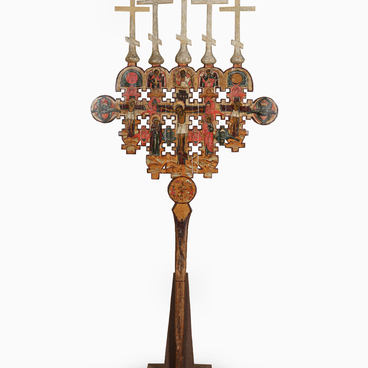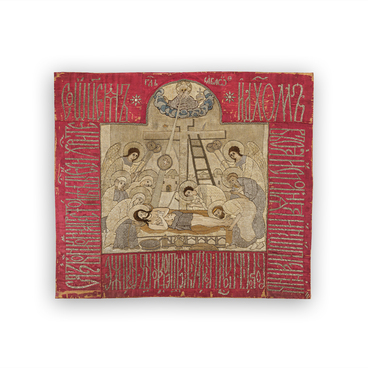The Greek word “mitra” literally means a headband. A miter is a type of durable headgear made of cloth with a rounded top. Miters are embroidered with gold, silver, and embellished with precious, semi-precious stones and pearls. The center and the sides of the miter are decorated with four enamel or embroidered miniature icons of Jesus Christ, the Mother of God, John the Baptist, a saint or holiday. At the top, such a headdress features a small icon of the Holy Trinity, a seraph or a miniature cross.
The miter of the priest is crowned with an icon. The bishop’s miter has a cross at the top. Such decorations are used to emphasize the solemnity of the episcopal service, as well as to complement the robes of bishops and honored priests.
Depending on the color of the vestments used during certain periods of the Liturgical year, there are different miters: yellow — for the most frequent services; white — for Easter services and the Twelve Great Feasts; blue — for the feasts of the Virgin; purple or burgundy — for the feasts of the Holy Cross and Sunday Lenten services; red — for the continuation of Easter services, on the days of the celebration of the Holy Martyrs; black — for Lenten services. Green miters are used to celebrate the Holy Trinity, the Palm Sunday, the Venerable, and the Holy Fools for Christ.
Church utensils made of expensive materials were donated to monasteries and churches as contributions from rich people. Many of them have been preserved to this day. Contributions were carefully recorded in contribution, feed, and inventory books, and the names of donors were entered in commemoration books.
The miter presented in the Museum of Russian Heritage was also a contribution to a monastery made to honor a deceased relative. Its silver plates feature the following inscription, “In the year of 7184, in April, on the 4th day, the widow of stolnik Fyodor Vladimirovich Buturlin, Marya Fyodorovna contributed this priestly miter to the Monastery of the Savior in the town of Belyov for her husband Fyodor and for her first husband Prokopy“.
Thus, a miter symbolically embodies the crown of thorns of the Lord and also represents the royal crown, the highest dignity of the archpastor, in the likeness of the Kingdom of Christ.







